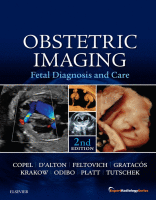Physical Address
304 North Cardinal St.
Dorchester Center, MA 02124

Introduction Talipes equinovarus (clubfoot) is an abnormality of the foot position. It may be positional, congenital (isolated), or part of a syndrome. Clubfoot resulting from in utero positional forces, as may occur with prolonged severe oligohydramnios, multiple gestation, or breech…

Introduction Congenital contractures in the newborn are actually common, ranging from 1 : 100 to 1 : 200 for some types of contractures that include clubfeet, hip dislocations, and multiple congenital contractures (MCCs). Talipes equinovarus or clubfoot is an abnormality of the foot position.…

Introduction The development of the fetal skull is a complex process involving intramembranous and endochondral ossification. The fetal cranium comprises bony plates that are joined together by areas of dense fibrous tissue termed cranial sutures, comprised of the sagittal, coronal,…

Introduction Routine second-trimester ultrasound (US) examination typically involves only a cursory evaluation of the extremities, documenting the presence or absence of the arms and legs; however, comprehensive evaluation of the fetal extremities often yields critical information. Anomalies of the hands…

Introduction Spinal malformations associated with vertebral segmentation defects and progressive fusions are seen in numerous syndromes, particularly those associated with skeletal dysplasias. Among spinal malformations, one of the best-described constellation of findings is Klippel-Feil syndrome (KFS), a triad of short…

Introduction Caudal regression syndrome (CRS), also known as caudal regression sequence, caudal dysplasia, caudal aplasia, femoral hypoplasia, phocomelic diabetic embryopathy, or sacral agenesis , is a spectrum of anomalies involving the caudal end of the trunk. The pathogenesis involves abnormal…

Introduction Among newborns with birth defects, approximately one-third show craniofacial abnormalities, which cause significant morbidity and mortality. More than 700 distinct craniofacial syndromes have been described to date. Facial dysostoses can be divided into two types: mandibulofacial dysostoses (MFDs) and…

Introduction Achondrogenesis II, hypochondrogenesis, platyspondylic Torrance type, spondyloepiphyseal dysplasia congenita (SEDC) ( Chapter 56 ), Kniest dysplasia, spondyloepimetaphyseal dysplasia, Strudwick type, Legg-Calve-Perthes disease, spondyloperipheral dysplasia, spondyloepiphyseal dysplasia with metatarsal shortening (Czech type), autosomal dominant spondyloarthropathy, and Stickler syndrome form the…

Introduction Spondyloepiphyseal dysplasias are rare, nonlethal disorders of bone growth. These disorders primarily affect the spine (spondylo-) and the ends of the long bones (epiphyseal), resulting in a short-trunk dwarfism. These disorders are clinically and genetically heterogeneous. Some spondyloepiphyseal dysplasias…

Introduction The short-rib polydactyly syndromes (SRPSs) are a genetically heterogeneous group of autosomal recessive skeletal disorders. Characteristic findings in SRPS include short horizontal ribs, shortened appendicular long bones limbs, and polydactyly. Historically, four distinct SRPS types have been recognized :…